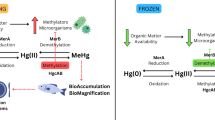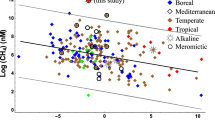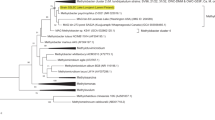Abstract
Patterns of diversity within methanogenic archaea in humic bog lakes are quantified over time and space to determine the roles that spatial isolation and seasonal mixing play in structuring microbial populations. The protein encoding gene mcrA is used as a molecular marker for the detection of fine-scale differences between methanogens in four dimictic bog lakes in which the water column is mixed twice a year and one meromictic lake that is permanently stratified. Although similar sequences are observed in each bog lake, each lake has its own characteristic set of persisting sequence types, indicating that methanogen populations are delimited either by low migration between the anaerobic hypolimnia or by lake-specific selection. The meromictic lake is differentiated from all other lakes and contains sequences with a higher degree of microdiversity than the dimictic lakes. By relating the structure of diversity to the depth of each bog lake, we propose the hypothesis that the deeper parts of the water column favor microdiversification of methanogens, whereas the periodically disturbed water column of shallower dimictic lakes promote genetically more diverse methanogen communities.
Similar content being viewed by others
Log in or create a free account to read this content
Gain free access to this article, as well as selected content from this journal and more on nature.com
or
Accession codes
References
Achtman M, Wagner M . (2008). Microbial diversity and the genetic nature of microbial species. Nat Rev Microbiol 6: 431–440.
Banning N, Brock F, Fry JC, Parkes RJ, Hornibrook ERC, Weightman AJ . (2005). Investigation of the methanogen population structure and activity in a brackish lake sediment. Environ Microbiol 7: 947–960.
Bräuer S, Cadillo-Quiroz H, Yashiro E, Yavitt JB, Zinder SH . (2006a). Isolation of a novel acidiphilic methanogen from an acidic peat bog. Nature 442: 192–194.
Bräuer S, Yashiro E, Ueno NG, Yavitt JB, Zinder SH . (2006b). Characterization of acid-tolerant H-2/CO2-utilizing methanogenic enrichment cultures from an acidic peat bog in New York State. FEMS Microbiol Ecol 57: 206–216.
Cadillo-Quiroz H, Brauer S, Yashiro E, Sun C, Yavitt J, Zinder S . (2006). Vertical profiles of methanogenesis and methanogens in two contrasting acidic peatlands in Central New York State, USA. Environ Microbiol 8: 1428–1440.
Cadillo-Quiroz H, Yashiro E, Yavitt JB, Zinder SH . (2008). Characterization of the archaeal community in a minerotrophic fen and terminal restriction fragment length polymorphism-directed isolation of a novel hydrogenotrophic methanogen. Appl Environ Microbiol 74: 2059–2068.
Chantratita N, Wuthiekanun V, Limmathurotsakul D, Vesaratchavest M, Thanwisai A, Amornchai P et al. (2008). Genetic diversity and microevolution of Burkholderia pseudomallei in the environment. Plos Neglected Tropical Diseases 2: e182.
Clayton L, Attig J, Mickelson D, Johnson M, Syverson K . (2002). Glaciation of Wisconsin. Wisconsin Geological and Natural History Survey, 3rd edn. Educational Series 36.
Collins G, Woods A, McHugh S, Carton MW, O’Flaherty V . (2003). Microbial community structure and methanogenic activity during start-up of psychrophilic anaerobic digesters treating synthetic industrial wastewaters. FEMS Microbiol Ecol 46: 159–170.
Connell JH . (1978). Diversity in tropical rain forests and coral reefs—high diversity of trees and corals is maintained only in a non-equilibrium state. Science 199: 1302–1310.
Curtis TP, Sloan WT . (2004). Prokaryotic diversity and its limits: microbial community structure in nature and implications for microbial ecology. Curr Opin Microbiol 7: 221–226.
Dhillon A, Lever M, Lloyd KG, Albert DB, Sogin ML, Teske A . (2005). Methanogen diversity evidenced by molecular characterization of methyl coenzyme M reductase A (McrA) genes in hydrothermal sediments of the guaymas basin. Appl Environ Microbiol 71: 4592–4601.
Earl J, Hall G, Pickup RW, Ritchie DA, Edwards C . (2003). Analysis of methanogen diversity in a hypereutrophic lake using PCR-RFLP analysis of Mcr sequences. Microbial Ecol 46: 270–278.
Eiler A, Bertilsson S . (2004). Composition of freshwater bacterial communities associated with cyanobacterial blooms in four Swedish lakes. Environ Microbiol 6: 1228–1243.
Eiler A, Bertilsson S . (2007). Flavobacteria blooms in four eutrophic lakes: linking population dynamics of freshwater bacterioplankton to resource availability. Appl Environ Microbiol 73: 3511–3518.
Erkel C, Kube M, Reinhardt R, Liesack W . (2006). Genome of rice cluster I archaea—the key methane producers in the rice rhizosphere. Science 313: 370–372.
Ermler U, Grabarse W, Shima S, Goubeaud M, Thauer RK . (1997). Crystal structure of methyl coenzyme M reductase: the key enzyme of biological methane formation. Science 278: 1457–1462.
Excoffier L, Laval G, Schneider S . (2005). Arlequin (version 3.0): an integrated software package for population genetics data analysis. Evolutionary Bioinformatics Online 1: 47–50.
Fraser C, Alm EJ, Polz MF, Spratt BG, Hanage WP . (2009). The bacterial species challenge: making sense of genetic and ecological diversity. Science 323: 741–746.
Galand PE, Saarnio S, Fritze H, Yrjala K . (2002). Depth related diversity of methanogen archaea in Finnish oligotrophic fen. FEMS Microbiol Ecol 42: 441–449.
Grundmann GL, Debouzie D . (2000). Geostatistical analysis of the distribution of NH4+ and NO2− oxidizing bacteria and serotypes at the millimeter scale along a soil transect. FEMS Microbiol Ecol 34: 57–62.
Hales BA, Edwards C, Ritchie DA, Hall G, Pickup RW, Saunders JR . (1996). Isolation and identification of methanogen-specific DNA from blanket bog feat by PCR amplification and sequence analysis. Appl Environ Microbiol 62: 668–675.
Huber T, Faulkner G, Hugenholtz P . (2004). Bellerophon; a program to detect chimeric sequences in multiple sequence alignments. Bioinformatics 20: 2317–2319.
Hudson RR, Slatkin M, Maddison WP . (1992). Estimation of levels of gene flow from DNA-sequence data. Genetics 132: 583–589.
Hunt DE, David LA, Gevers D, Preheim SP, Alm EJ, Polz MF . (2008). Resource partitioning and sympatric differentiation among closely related bacterioplankton. Science 320: 1081–1085.
Jones SE, Chiu CY, Kratz TK, Wu JT, Shade A, McMahon KD . (2008). Typhoons initiate predictable change in aquatic bacterial communities. Limnol Oceanography 53: 1319–1326.
Jones SE, McMahon KD . (2009). Species-sorting may explain an apparent minimal effect of immigration on freshwater bacterial community dynamics. Environ Microbiol 11: 905–913.
Juday C, Birge E . (1941). Hydrography and morphometry of some Northeastern Wisconsin lakes. Trans Wisconsin Acad Sci Arts and Lett 33: 21–72.
Juottonen H, Galand PE, Yrjala K . (2006). Detection of methanogenic archaea in peat: comparison of PCR primers targeting the McrA gene. Res Microbiol 157: 914–921.
Kent AD, Jones SE, Yannarell AC, Graham JM, Lauster GH, Kratz TK et al. (2004). Annual patterns in bacterioplankton community variability in a humic lake. Microbial Ecol 48: 550–560.
Klepac-Ceraj V, Bahr M, Crump BC, Teske AP, Hobbie JE, Polz MF . (2004). High overall diversity and dominance of microdiverse relationships in salt marsh sulphate-reducing bacteria. Environ Microbiol 6: 686–698.
Kumar S, Nei M, Dudley J, Tamura K . (2008). MEGA: a biologist-centric software for evolutionary analysis of DNA and protein sequences. Briefings Bioinformatics 9: 299–306.
Leclerc M, Delbes C, Moletta R, Godon JJ . (2001). Single strand conformation polymorphism monitoring of 16S rDNA archaea during start-up of an anaerobic digester. FEMS Microbiol Ecol 34: 213–220.
Leclerc M, Delgenes JP, Godon JJ . (2004). Diversity of the archaeal community in 44 anaerobic digesters as determined by single strand conformation polymorphism analysis and 16S rDNA sequencing. Environ Microbiol 6: 809–819.
Lehours AC, Bardot C, Thenot A, Debroas D, Fonty G . (2005). Anaerobic microbial communities in Lake Pavin, a unique meromictic lake in France. Appl Environ Microbiol 71: 7389–7400.
Lehours AC, Evans P, Bardot C, Joblin K, Gerard F . (2007). Phylogenetic diversity of archaea and bacteria in the anoxic zone of a meromictic lake (Lake Pavin, France). Appl Environ Microbiol 73: 2016–2019.
Lozupone C, Hamady M, Knight R . (2006). UniFrac—an online tool for comparing microbial community diversity in a phylogenetic context. BMC Bioinformatics 7: 371.
Ludwig W, Strunk O, Westram R et al. (2004). ARB: a software environment for sequence data. Nucleic Acids Res 32: 1363–1371.
Lueders T, Chin KJ, Conrad R, Friedrich M . (2001). Molecular analyses of methyl-coenzyme M reductase alpha-subunit (McrA) genes in rice field soil and enrichment cultures reveal the methanogenic phenotype of a novel archaeal lineage. Environ Microbiol 3: 194–204.
Lueders T, Friedrich M . (2000). Archaeal population dynamics during sequential reduction processes in rice field soil. Appl Environ Microbiol 66: 2732–2742.
Luton PE, Wayne JM, Sharp RJ, Riley PW . (2002). The McrA gene as an alternative to 16S rRNA in the phylogenetic analysis of methanogen populations in landfill. Microbiol-Sgm 148: 3521–3530.
Maeder DL, Anderson I, Brettin TS, Bruce DC, Gilna P, Han CS et al. (2006). The Methanosarcina barkeri genome: comparative analysis with Methanosarcina acetivorans and Methanosarcina mazei reveals extensive rearrangement within methanosarcinal genomes. J Bacteriol 188: 7922–7931.
Middelboe M, Hagstrom A, Blackburn N, Sinn B, Fischer U, Borch NH et al. (2001). Effects of bacteriophages on the population dynamics of four strains of pelagic marine bacteria. Microbial Ecol 42: 395–406.
Nelson CE . (2009). Phenology of high-elevation pelagic bacteria: the roles of meteorologic variability, catchment inputs and thermal stratification in structuring communities. ISMEJ 3: 13–30.
Paradis E, Claude J, Strimmer K . (2004). APE: analyses of phylogenetics and evolution in R language. Bioinformatics 20: 289–290.
Pender S, Toomey M, Carton M, Eardly D, Patching JW, Colleran E et al. (2004). Long-term effects of operating temperature and sulphate addition on the methanogenic community structure of anaerobic hybrid reactors. Water Res 38: 619–630.
R development core team (2009). R: a language and environment for statistical computing. R Foundation for Statistical Computing http://www.R-project.org.
Rocap G, Larimer FW, Lamerdin J, Malfatti S, Chain P, Ahlgren NA . et al. (2003). Genome divergence in two prochlorococcus ecotypes reflects oceanic niche differentiation. Nature 424: 1042–1047.
Schloss PD, Handelsman J . (2005). Introducing DOTUR, a computer program for defining operational taxonomic units and estimating species richness. Appl Environ Microbiol 71: 1501–1506.
Shade A, Jones SE, McMahon KD . (2008). The influence of habitat heterogeneity on freshwater bacterial community composition and dynamics. Environ Microbiol 10: 1057–1067.
Shade A, Kent AD, Jones SE, Newton RJ, Triplett EW, McMahon KD . (2007). Interannual dynamics and phenology of bacterial communities in a Eutrophic lake. Limnol Oceanography 52: 487–494.
Wetzel RG . (2001). Limnology: Lake and River Ecosystems. Academic Press: London, UK, 850.
Whitaker RJ, Grogan DW, Taylor JW . (2003). Geographic barriers isolate endemic populations of hyperthermophilic archaea. Science 301: 976–978.
Winfrey MR, Zeikus JG . (1979). Microbial methanogenesis and acetate metabolism in a meromictic lake. Appl Environ Microbiol 37: 213–221.
Wright S . (1951). The genetical structure of populations. Ann Eugenics 15: 323–354.
Wu QL, Hahn MW . (2006). Differences in structure and dynamics of polynucleobacter communities in a temperate and a subtropical lake, revealed at three phylogenetic levels. FEMS Microbiol Ecol 57: 67–79.
Yannarell AC, Triplett EW . (2005). Geographic and environmental sources of variation in lake bacterial community composition. Appl Environ Microbiol 71: 227–239.
Zumstein E, Moletta R, Godon JJ . (2000). Examination of two years of community dynamics in an anaerobic bioreactor using fluorescence polymerase chain reaction (PCR) single-strand conformation polymorphism analysis. Environ Microbiol 2: 69–78.
Zwart G, Crump BC, Agterveld MPKV, Hagen F, Han SK . (2002). Typical freshwater bacteria: an analysis of available 16S rRNA gene sequences from plankton of lakes and rivers. Aquatic Microbial Ecol 28: 141–155.
Zwickl DJ . (2008). GARLI (genetic algorithm for rapid likelihood inference) https://www.nescent.org/wg_garli/Main_Page.
Acknowledgements
We thank KD McMahon, A Shade, C Caceres and H Cadillo-Quiroz for critical feedback, and discussion of methods and results, B Dalsing and D Mattis for assistance with DNA extractions and sequencing, A Shade and students and staff at UW Madison Trout Lake Station for assistance with sampling and P Burke, N Held, M Reno and three anonymous reviewers for helpful comments on the article. Funding was provided by NSF via the North Temperate Lakes Microbial Observatory (MCB-0702653) and the North Temperate Lakes Long Term Ecological Research Site (NTL-LTER) (NSF DEB-0217533 and DEB-0822700).
Author information
Authors and Affiliations
Corresponding author
Additional information
Supplementary Information accompanies the paper on The ISME Journal website
Supplementary information
Rights and permissions
About this article
Cite this article
Milferstedt, K., Youngblut, N. & Whitaker, R. Spatial structure and persistence of methanogen populations in humic bog lakes. ISME J 4, 764–776 (2010). https://doi.org/10.1038/ismej.2010.7
Received:
Revised:
Accepted:
Published:
Issue date:
DOI: https://doi.org/10.1038/ismej.2010.7
Keywords
This article is cited by
-
Patterns of Denitrification and Methanogenesis Rates from Vernal Pools in a Temperate Forest Driven by Seasonal, Microbial Functional Gene Abundances, and Soil Chemistry
Wetlands (2020)
-
Anaerobic Metabolism in Tidal Freshwater Wetlands: II. Effects of Plant Removal on Archaeal Microbial Communities
Estuaries and Coasts (2013)



